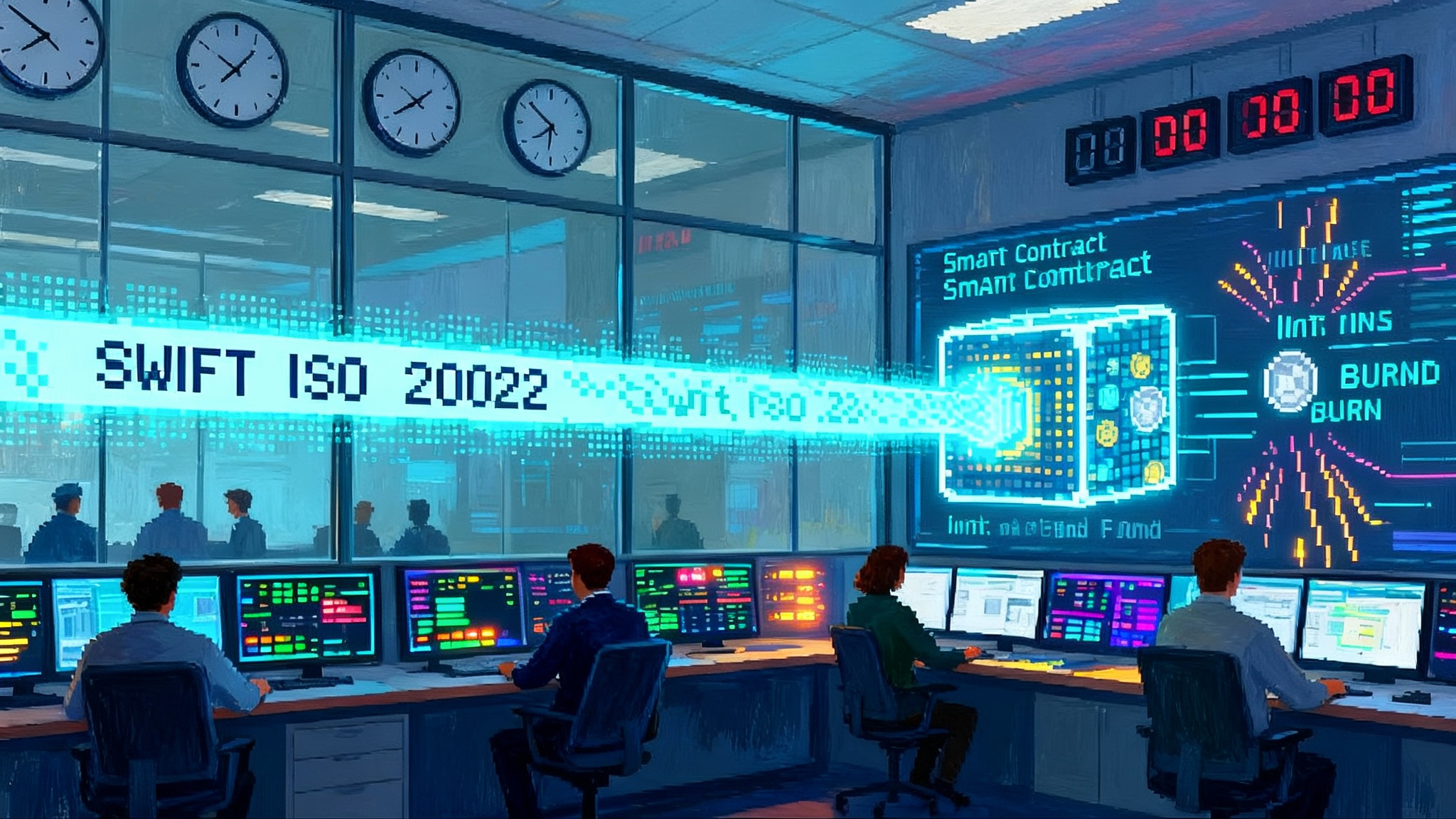Fusaka blob surge ignites Ethereum’s 2026 DA wars
Ethereum’s December Fusaka upgrade widens the blob pipeline and sets scheduled capacity increases, cutting volatility and enabling policy based routing across data availability layers. Here is how rollups will rebalance between L1 blobs and providers like EigenDA, Celestia, and Avail, and who stands to gain share in 2026.

Breaking: Fusaka flips the DA switch
Ethereum’s December Fusaka upgrade is the kind of change you only feel once it hits production. Blobs, the data packets that rollups publish to Ethereum for data availability, are about to get more plentiful and cheaper on average. Fusaka raises the target for how many blobs can be included in each slot and raises the ceiling for peak bursts. On top of that, the network will follow a schedule of increases to the blobs per slot objective, with telemetry gates to keep the system healthy. Rollups that have treated Layer 1 blobs like a scarce luxury now see a runway for sustained use. For background, see EIP-4844 proto-danksharding and the Ethereum rollups overview.
If Dencun in 2024 was the warm up, Fusaka is the whistle that starts the real game. Data availability, often shortened to DA, is the scarce resource that decides how many transactions rollups can safely include and how cheaply they can do it. In 2026, we will see a full blown DA war. The contest is not only between Ethereum’s native blob market and outside providers like Celestia, EigenDA, and Avail. The battle lines also cut across fee curves, bandwidth guarantees, and new coordination layers such as Peer Data Availability Sampling, shared sequencers, and the restaking ecosystem. The winners will not be the loudest brands, but the stacks that deliver predictable bandwidth, finality that users trust, and routing logic that treats DA like a smart commodity. For adjacent context on rollup correctness, see our piece on Arbitrum and OP Stack fault proofs.
What changed with Fusaka
Fusaka delivers three meaningful shifts for rollups and builders:
-
Higher blob capacity. The protocol raises the target number of blobs per slot, while also lifting the maximum burst capacity. In plain terms, the pipe is wider and can swell more during spikes. That means rollups can publish more data to Ethereum without choking one another during a busy minute.
-
A firmer, smoother fee curve. Like the base fee for gas, the blob base fee adjusts as demand rises or falls. With the new target and ceiling, the adjustment curve becomes smoother around the new average, which lowers fee volatility for steady publishers like general purpose rollups.
-
A schedule for increases. Fusaka introduces staged bumps to the blobs per slot objective, gated by live network health checks. This is a promise that capacity will keep ratcheting up if the network stays stable. Builders get something to plan against, not just a one off uplift.
Each of these matters for daily operations. If you run the batcher for a rollup like Base or Arbitrum, lower variance in blob pricing means you can set tighter fees for users without being blindsided by a spike. If you operate a high throughput app chain for gaming or social, a larger burst ceiling lets you clear a surge of activity without spilling to a slower plan B.
The strategic consequence: routing becomes rational
Before Fusaka, many rollups treated Ethereum blobs as the premium aisle. When things got crowded, some explored alternative data availability layers such as Celestia, EigenDA, or Avail. The choice often came down to a simple rule of thumb. If L1 blobs are cheap and available, use them. If not, shift batches to an external provider with a clear price and a throughput guarantee.
Fusaka pushes that tradeoff into a more systematic regime. With capacity scheduled to grow, and a steadier fee curve, rollups can implement dynamic routing that chooses between L1 blobs and alternative DA on a per batch basis. Think of it like a modern shipping desk. If the express lane has room and the price is right, you use it. If not, you place the parcel on a reliable ground service with a transparent time and cost. The point is not loyalty, it is predictable delivery and clear service level.
Who stands to gain market share
Winners will emerge for different reasons. Here is where the momentum points as 2026 approaches.
-
Ethereum native rollups with flexible batchers. Teams that already publish to L1 blobs but wired in adapters for external DA will benefit first. Expect Optimism stack chains and Arbitrum Orbit chains that upgraded their batchers to route on price and latency to win user trust. Base and other consumer facing chains can turn cheaper blobs into steadier end user fees.
-
EigenDA as the aligned alternative. EigenDA leans on Ethereum aligned security through restaking and can offer high throughput lanes with explicit bandwidth commitments. For rollups that want the feel of Ethereum’s trust model but need guaranteed capacity during peak campaigns, EigenDA is the natural complement to L1 blobs.
-
Celestia for high bandwidth verticals. Celestia’s design favors large volumes of data with predictable pricing. That is attractive to gaming, social, and data heavy app chains that need many megabytes per minute without price shocks. If L1 blob prices stay moderate most of the time, these chains can mix in L1 for checkpoints while relying on Celestia as the daily workhorse.
-
Avail as the aggregator’s friend. Avail’s focus on unification primitives and cross chain data commitments makes it a fit for builders who intend to live across multiple rollup domains. Expect bridge providers, intent routers, and shared sequencer networks to look closely at Avail as a neutral substrate for interop proofs. For the interop angle, compare with POL and AggLayer reset liquidity.
-
Shared sequencer providers. Companies building shared sequencing layers, such as Espresso style networks or Astria like systems, gain because better DA only amplifies the value of reliable ordering. If they can bundle cross rollup transactions and publish them to whichever DA rail is cheapest at the moment with guaranteed inclusion, they become the air traffic control for L2 liquidity.
The laggards will be chains that remain single homed on one DA provider without fallbacks, or that run batchers with manual knobs instead of policy based routing. In a market that prices bandwidth every few seconds, you do not want a human in the loop.
Fee curves are about to matter more than brands
The blob base fee rises when blocks are above the target and falls when they are below. With Fusaka’s higher target, average prices should settle lower at most times of day. But that does not mean cheap forever. During synchronized spikes, like major NFT drops or onchain game tournaments, the fee will still surge. What changes is the slope and the recovery time. Expect faster reversion to the new lower mean and fewer hours per week where blobs feel prohibitively expensive.
Alternative DA providers will respond with clearer pricing tiers. We will likely see two models:
-
Pay as you go with congestion multipliers. This mimics Ethereum’s fee dynamics but starts from a lower base. It is attractive to smaller chains and to bursty workloads that can back off when price jumps.
-
Reserved bandwidth with explicit guarantees. This looks like a mobile data plan. You buy a monthly quota of megabytes per minute, with an overage price that is known in advance. It is the model that appeals to exchanges, games, or social networks that refuse to degrade during peak hours.
The frontier is the ability to lock an explicit inclusion probability at a price. Expect service level agreements that read like, publish within two slots with 99.9 percent probability at X dollars per megabyte when the network is below a set load. Ethereum cannot promise that kind of contract at the application layer, and it should not. External DA providers can, and that is where they will differentiate.
Bandwidth guarantees and the new peering economy
Capacity promises are only useful if they connect to the rest of the stack. Two developments make these guarantees meaningful in practice.
-
Peer Data Availability Sampling. Instead of having every full node bear the entire blob, the network lets many nodes randomly sample small parts to verify that the whole data block is available. Imagine checking a bag of rice by sampling spoonfuls from many locations. If enough peers can retrieve their spoons, the bag is almost certainly intact. This method multiplies effective capacity without centralizing the network. For rollups, it raises the confidence that a published blob will remain retrievable for its required window.
-
Shared sequencers. Today, each rollup often runs its own sequencer, which can work fine but fractures liquidity and makes cross rollup trades clumsy. Shared sequencers offer a neutral place to order transactions across many rollups at once. If they can write to both L1 blobs and alternative DA in the same step, then bandwidth guarantees from a DA provider translate into real inclusion guarantees for the cross rollup bundles.
Once these two pieces are live at scale, DA becomes a tradable commodity between machines. Sequencers will peer with multiple DA providers the way content delivery networks peer with multiple transit networks. They will route batch publications to the cheapest available lane that meets the current guarantee, and they will arbitrage between lanes in minutes rather than months.
Restaking moves from ideology to logistics
Restaking began as a way to reuse Ethereum’s economic security for new services. In 2026, it becomes logistics. Rollups, sequencers, and DA providers will rely on restaked operators for three reasons.
-
Fast spin up of new committees. Need a data availability committee to provide an audit trail for a high stakes launch week. Spin one using restaked operators with measurable performance histories.
-
Aligned slashing. If a DA provider promises a bandwidth guarantee and fails to deliver, restaked bonds can be slashed under a transparent set of rules. This is a real insurance policy rather than a marketing promise.
-
Unified trust story. Users are skeptical of exotic trust assumptions. When services anchor their promises to restaked Ethereum stake, it gives wallets, bridges, and exchanges a coherent line to draw when explaining risk.
Expect EigenDA to lean heavily on restaking to publish tight bandwidth guarantees. Expect shared sequencer networks to delegate portions of their ordering or data availability committees to restaked operators. Expect risk managers at exchanges and custodians to ask whether a chain’s DA and sequencing guarantees are backed by slashable stake they recognize.
How rollups will rebalance in practice
A year ago, a rollup might have used Ethereum blobs exclusively and hoped for the best. In 2026, the default will be dual or tri homed DA, with automated policies deciding where each batch goes.
-
General purpose rollups. They will route most batches to L1 blobs during normal times and reserve a small quota with an external DA for peak events. Their policy engine will watch blob base fees and latency, then switch lanes when price crosses a defined threshold.
-
App specific chains with high bandwidth needs. They will reserve large lanes on an external DA provider and use L1 blobs for checkpoints, fraud proof windows, and marketing moments where L1 inclusion is part of the story. The policy will prefer deterministic throughput over the lowest possible price.
-
Bridges, intents, and cross rollup protocols. They will publish proof material to multiple DAs at once, aiming for the fastest route to shared sequencers and the broadest set of verifiers. If a route misbehaves, they will fall back to L1 blobs within a fixed time budget. On the wallet side, watch how post Pectra smart wallets reshape user expectations for finality and confirmations.
The most successful teams will treat DA like cloud storage with traffic engineering. They will buy reserved capacity for their base load, keep a credit card ready for on demand capacity during spikes, and snapshot critical states to L1 on a fixed schedule to keep users calm.
The likely 2026 leaderboard
Prediction is not science, but the incentives are clear enough to sketch probability bands.
-
Ethereum L1 blob market grows share of total rollup DA bytes in quiet hours. Fusaka makes the average hour cheaper. As the scheduled objective rises, more general purpose rollups find that the default lane suffices for most days.
-
EigenDA grows fastest among Ethereum aligned alternatives. Its value proposition slots neatly next to L1 blobs. Expect it to become the first choice for reserved lanes and launch week guarantees for teams that want Ethereum style trust with more control over capacity.
-
Celestia dominates data hungry verticals. If you plan to stream large payloads for games or social graphs, predictable pricing and large guaranteed lanes win. Celestia will become the default behind several consumer apps, even when those apps checkpoint to L1.
-
Avail gains with interop providers and shared sequencers. By focusing on proof oriented features and cross domain commitments, Avail becomes the glue in several multi rollup architectures.
-
Niche DA entrants consolidate or partner. Smaller networks without a unique advantage will either specialize in a region, a compliance niche, or will be absorbed into shared sequencer ecosystems as regional edge providers.
What changes for users and developers
For users, the tell will be steadier fees and faster cross rollup actions. A swap that touches two rollups should feel as quick as a single chain swap in 2024. Bridges will display clearer timers and fewer surprises. Busy nights will cost more, but not ruinously more, and the surge should end in minutes rather than hours.
For developers, the slog moves from building custom sequencers to writing policy for routers. The questions to answer:
- What is your base load in megabytes per minute during quiet hours, and where will you place it by default.
- What is your tolerance for delay during peaks, and what price will you pay to avoid it.
- How will you checkpoint to L1 for user confidence, and how often.
- Which restaked committees, if any, back the guarantees you rely on, and what are the explicit slashing conditions.
Teams should instrument their batchers like trading systems. Measure the effective cost per byte, the time to inclusion, and the variance over a week. Run drills that force the router to fail over between lanes. Publish a plain language policy to your users so they know what to expect during a rush.
Why PeerDAS plus shared sequencers plus restaking consolidates L2 liquidity
This combination reduces the three frictions that fragment liquidity.
-
Data availability bottlenecks. PeerDAS increases capacity without weakening verification, so more bundles fit without slowdowns. Users experience fewer congested windows, and arbitrage across rollups becomes reliable.
-
Ordering fragmentation. Shared sequencers enable cross rollup bundles with predictable inclusion. This lets exchanges, perps protocols, and intent routers coordinate trades across many rollups in one stroke, which tightens prices and pulls liquidity into venues that support shared ordering.
-
Trust sprawl. Restaking offers a single trust anchor that many services can use. Instead of asking users to understand five new sets of incentives, builders can point to a common stake pool with clear slashing rules. That reduces the cognitive tax and accelerates adoption.
When these three align, the path of least resistance for asset issuers, market makers, and app developers is to settle on a small number of rollups that plug into the same shared sequencer and the same DA mix. Liquidity attracts liquidity. Once critical mass forms, the incentives to fragment fade because the best execution and the best user experience sit behind the shared rails.
What to watch between now and mid 2026
-
Blob base fee percentiles. If the 50th percentile price stays meaningfully below pre Fusaka levels and the 95th percentile spikes shorten, the thesis is playing out.
-
Adoption of policy based routing in batchers. Look for release notes that mention dynamic DA routing by price and latency. If the majors adopt standard routers, the market will move quickly.
-
Concrete bandwidth guarantees from DA providers. The moment providers publish explicit megabytes per minute with penalties for failure, the procurement game begins in earnest.
-
Shared sequencer deployments with real volume. A few proofs of concept do not count. Watch for cross rollup perps, auctions, or intents traffic reaching consistent daily volumes.
-
Restaked committees tied to service levels. It is not enough to have restaking. The key is a direct line between guarantees and slashable stake with published conditions.
The bottom line
Fusaka does not settle the data availability war. It starts it in earnest. By raising blob capacity and mapping a path for more, Ethereum makes L1 blobs a viable default for far more rollups. That forces alternative DA providers to compete on guarantees, not slogans. The stack that wins is the one that treats data availability as a programmable commodity, ordered by shared sequencers, and backed by restaked security that users can understand.
If you build a rollup, do three things now. Upgrade your batcher to support policy based routing between L1 blobs and at least one external DA. Engage with a shared sequencer network and make cross rollup bundles a day one feature. Tie your guarantees to restaked committees with explicit slashing. If you manage liquidity, route to venues that publish these details and hold them to it. By the time the scheduled blob objective increases finish rolling through 2026, the chains that practiced these habits will not only run cheaper. They will own the flow.








